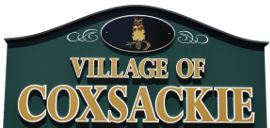The Village of Coxsackie is located on the west side of the Hudson River in Greene County, NY.
The name “Coxsackie” comes from an Algonquin Indian word believed to mean “Place of Owls”, “Migrating Geese”, or “Cut Rocks”. Coxsackie has been spelled many different ways before its present day spelling. Some of the earlier versions are: Koxhacking, Kasakee, and Koixhacking. The Indians called the flats Caniskeek.
The Upper Village (West Coxsackie) was the first settlement in Coxsackie. Many of the old houses still remain. The Village of Coxsackie was part of the Mathias Houghtaling patent, granted in 1697. The only home in the village was owned by a French physician, Dr. Claude Ducalon, who was here as early as 1744.
At the start of the 1800’s, the present village of Coxsackie was purchased by Eliakim Reed, where he established a small wharf. The present business district was laid out in about 1810, and grew rapidly due to the shipping of farm goods and ice to the New York City area by way of the Hudson River. The “Landing” endured a fire which burned much of the Reed Street district in 1864. The loss was calculated to be about $35,000. At that time, after the fire, Reed Street was widened to its present width.
By an act of the New York State Legislature, the Village of Coxsackie was incorporated April 5, 1867. This allowed collection of taxes for sewer, water, street lights, and police protection. At that time the Village comprised of 610 acres.
The Village cemetery on Mansion Street was established in 1826, and many of the early residents lie in rest there. The First Reformed Church, the oldest church in Greene County, was established in about 1732. The West Shore Railroad, which ran through West Coxsackie had its trestle built by hand digging under the tracks in about 1935.
The Reed Street Historic District and Riverside Park remain intact along the bank of the Hudson River. The Riverfront was declared a New York State area of scenic significance in the 1990’s.
Information provided by former Village of Coxsackie Historian,
Margaret A. Chaloner
